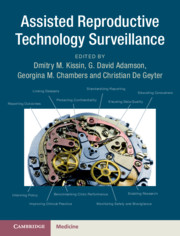Book contents
- Frontmatter
- Contents
- Foreword
- List of Contributors
- Section 1 Introduction to ART Surveillance
- Section 2 General Principles of ART Surveillance
- Section 3 Using ART Surveillance Data
- 5 Reporting ART Success Rates
- 6 Using ART Surveillance Data in Clinical Research
- 7 Monitoring ART Safety and Biovigilance
- 8 Quality Assurance of ART Practice: Using Data to Improve Clinical Care
- 9 Monitoring Long-Term Outcomes of ART: Linking ART Surveillance Data with Other Datasets
- 10 Use of ART Surveillance by People Experiencing Infertility
- Section 4 Global Variations in ART Surveillance
- Section 5 Surveillance of Non-ART Fertility Treatments
- Appendix A ART Surveillance System Variables and Definitions
- Appendix B International Glossary on Infertility and Fertility Care
- Appendix C ICMART Data Collection Form
- Index
- Plates
8 - Quality Assurance of ART Practice: Using Data to Improve Clinical Care
from Section 3 - Using ART Surveillance Data
Published online by Cambridge University Press: 14 June 2019
- Frontmatter
- Contents
- Foreword
- List of Contributors
- Section 1 Introduction to ART Surveillance
- Section 2 General Principles of ART Surveillance
- Section 3 Using ART Surveillance Data
- 5 Reporting ART Success Rates
- 6 Using ART Surveillance Data in Clinical Research
- 7 Monitoring ART Safety and Biovigilance
- 8 Quality Assurance of ART Practice: Using Data to Improve Clinical Care
- 9 Monitoring Long-Term Outcomes of ART: Linking ART Surveillance Data with Other Datasets
- 10 Use of ART Surveillance by People Experiencing Infertility
- Section 4 Global Variations in ART Surveillance
- Section 5 Surveillance of Non-ART Fertility Treatments
- Appendix A ART Surveillance System Variables and Definitions
- Appendix B International Glossary on Infertility and Fertility Care
- Appendix C ICMART Data Collection Form
- Index
- Plates
Summary
Medical registries are frequently used to generate quality measures with the objective of improving the provision of medical care. Assisted reproductive technology (ART) registries can be used in this manner even if they were initially created for other purposes. Aggregate registry outcomes can be used for internal benchmarking purposes by individual programs. This data can also be used for external Quality Assurance purposes to identify programs that are outliers (low success rates or high multiple gestation rates). Collection of detailed cycle specific information allows benchmarking of process measures that can allow easy identification of specific areas for improvement. Ongoing, daily collection and reporting of key performance indicators (e.g. fertilization rates, embryo development rates) can be used to produce Shewart type control charts to promptly identify and remediate issues that could ultimately result in low birth rates or high risk of multiple gestation.
Keywords
- Type
- Chapter
- Information
- Assisted Reproductive Technology Surveillance , pp. 69 - 80Publisher: Cambridge University PressPrint publication year: 2019

